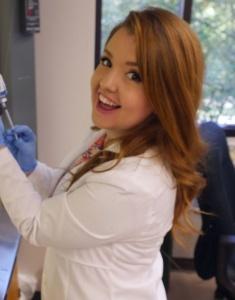
As an undergraduate, Miranda Shipman studied drawing and painting, teaching art and managing a gallery until she developed a rare brain tumor. After she had the tumor removed, Shipman developed a passion for neuroscience, with the hope of helping to discover new treatments. Now she’s helping to do just that in the lab of Nicole Calakos, MD, PhD, where she’s screening compounds to help people living with dystonia. For this week’s spotlight interview, Shipman talks to us about this work, how her interests in art and neuroscience complement each other, and helping patients with brain tumors in her spare time.
What are your current responsibilities within the Calakos lab? What does a typical day look like for you?
I am currently a research analyst for the Calakos lab and also serve as our lab’s manager. My role in the lab encompasses many different responsibilities, so no day is the same, which I love. I can be found doing anything from onboarding new members, working on our drug discovery projects, doing brain dissections or viral surgeries on mice.
What research projects are you currently working on? How will they help us better understand or treat movement disorders?
My work primarily focuses on a disease called dystonia, which is a rare movement disorder and I work doing drug discovery. We have screened novel compounds in an effort to find some that correct a disease phenotype, so we can move forward creating a drug for those with dystonia. This process is challenging and exciting. We get to see and work in all aspects of the drug discovery process, from high-throughput screening, to medicinal chemistry, to target identification and validation. My hope is that we will soon be able to create a drug and positively impact the lives of those living with dystonia.
How and when did you first get interested in neuroscience research?
I actually went to school for art, where I focused in painting and drawing. After college I became a director of an art gallery in Texas and also taught art to kids and adults. I was happy in my career, but suddenly got very sick. It took 10 months to find out that over the course of many years, I had developed a massive, rare brain tumor.
Once I had it removed, I became interested in research and went back to school for neuroscience. The main goal was to be a part of research that would eventually help treat diseases, which is why I love working in drug discovery. There is currently no treatment for the type of brain tumor I had, other than surgery (and sometimes radiation), and I hated the thought of not actively trying to change that, whether it be for my tumor type, or for any other disease that doesn’t have adequate treatment.
What do you enjoy most about your work?
It’s never boring! You never know how things will turn out, which makes you think about every possible aspect of what you’re working on. Knowing that you’re working to help someone else’s future is also extremely fulfilling. Having a tight knit group of people in our lab is a great bonus to working here too. They make working here fun.
What’s the hardest part of your job?
I think the hardest part is troubleshooting when you’re navigating a new experiment. In most everything I work on there are so many variables to keep in mind. It keeps things interesting, though.
In addition to your background in neuroscience you’re also an accomplished artist. What styles or disciplines are you most interested in? How do your interests in art and neuroscience complement or otherwise influence each other?
Yes, I love art, and worked in it for a long time before switching to neuro. I typically do photorealistic paintings, but I also love doing pottery, because it’s so hard that there’s no pressure for perfection. I also love finding artists that take traditional mediums and modernize them.
One of my favorite artists is Bisa Butler, who is a quilter, but instead of traditional quilts, does photorealistic portraits. What I found after making the transition to neuro is that artists and scientists are really similar in a lot of ways, one way is the creativity you have to bring to the table in both disciplines.
What other passions or hobbies do you have outside of the Neurology Department?
I work with the Epidermoid Brain Tumor Society, helping patients and caregivers navigate the process of brain surgery and recovery. In my free time I love to bake cakes, travel, go canoeing and camping. I also love spending time with my family and our dog.

Above, Shipman enjoys a recent camping trip. Below, a painting Shipman painted to illustrate a recent study from the Calakos lab, where a bookie looks through special binoculars to pick the winner of a horse race. He sees the odds are stacked in favor of the horse, “Habit”, who has a head-start on the line, reflecting the timing bias in which firing of the direct or “Go” pathway precedes the indirect pathway, and is more muscular, reflecting the strengthening of both the direct and indirect pathway.
